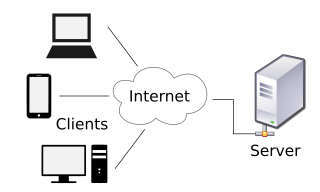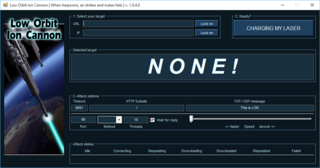
Client-server model is a distributed application structure that partitions tasks or workloads between the providers of a resource or service, called servers, and service requesters, called clients. Often clients and servers communicate over a computer network on separate hardware, but both client and server may reside in the same system. A server host runs one or more server programs, which share their resources with clients. A client usually does not share any of its resources, but it requests content or service from a server. Clients, therefore, initiate communication sessions with servers, which await incoming requests. Examples of computer applications that use the client-server model are email, network printing, and the World Wide Web.

An exploit is a piece of software, a chunk of data, or a sequence of commands that takes advantage of a bug or vulnerability to cause unintended or unanticipated behavior to occur on computer software, hardware, or something electronic. Such behavior frequently includes things like gaining control of a computer system, allowing privilege escalation, or a denial-of-service attack.

DALnet is an Internet Relay Chat (IRC) network made up of 33 servers, with a stable population of approximately 8,000 users in about 7,000 channels.

In computing, a denial-of-service attack is a cyber-attack in which the perpetrator seeks to make a machine or network resource unavailable to its intended users by temporarily or indefinitely disrupting services of a host connected to a network. Denial of service is typically accomplished by flooding the targeted machine or resource with superfluous requests in an attempt to overload systems and prevent some or all legitimate requests from being fulfilled.
mydoom also known as, my.doom, W32.MyDoom@mm, Novarg, Mimail.R and Shimgapi, is a computer worm affecting Microsoft Windows. It was first sighted on January 26, 2004. It became the fastest-spreading e-mail worm ever, exceeding previous records set by the Sobig worm and ILOVEYOU, a record which as of 2022 has yet to be surpassed.

In computing, a zombie is a computer connected to the Internet that has been compromised by a hacker via a computer virus, computer worm, or trojan horse program and can be used to perform malicious tasks under the remote direction of the hacker. Zombie computers often coordinate together in a botnet controlled by the hacker, and are used for activities such as spreading e-mail spam and launching distributed denial-of-service attacks against web servers. Most victims are unaware that their computers have become zombies. The concept is similar to the zombie of Haitian Voodoo folklore, which refers to a corpse resurrected by a sorcerer via magic and enslaved to the sorcerer's commands, having no free will of its own. A coordinated DDoS attack by multiple botnet machines also resembles a "zombie horde attack", as depicted in fictional zombie films.

A botnet is a number of Internet-connected devices, each of which runs one or more bots. Botnets can be used to perform Distributed Denial-of-Service (DDoS) attacks, steal data, send spam, and allow the attacker to access the device and its connection. The owner can control the botnet using command and control (C&C) software. The word "botnet" is a portmanteau of the words "robot" and "network". The term is usually used with a negative or malicious connotation.

Internet security is a branch of computer security. It encompasses the Internet, browser security, web site security, and network security as it applies to other applications or operating systems as a whole. Its objective is to establish rules and measures to use against attacks over the Internet. The Internet is an inherently insecure channel for information exchange, with high risk of intrusion or fraud, such as phishing, online viruses, trojans, ransomware and worms.
On Internet usage, an email bomb is a form of net abuse that sends large volumes of email to an address to overflow the mailbox, overwhelm the server where the email address is hosted in a denial-of-service attack or as a smoke screen to distract the attention from important email messages indicating a security breach.

The Storm botnet or Storm worm botnet is a remotely controlled network of "zombie" computers that have been linked by the Storm Worm, a Trojan horse spread through e-mail spam. At its height in September 2007, the Storm botnet was running on anywhere from 1 million to 50 million computer systems, and accounted for 8% of all malware on Microsoft Windows computers. It was first identified around January 2007, having been distributed by email with subjects such as "230 dead as storm batters Europe," giving it its well-known name. The botnet began to decline in late 2007, and by mid-2008 had been reduced to infecting about 85,000 computers, far less than it had infected a year earlier.
Linode, LLC is an American privately-owned cloud hosting company that provides virtual private servers. It is based in Philadelphia, Pennsylvania.

Low Orbit Ion Cannon (LOIC) is an open-source network stress testing and denial-of-service attack application written in C#. LOIC was initially developed by Praetox Technologies, however it was later released into the public domain and is currently available on several open-source platforms.
United States of America v. Ancheta is the name of a lawsuit against Jeanson James Ancheta of Downey, California by the U.S. Government and was handled by the United States District Court for the Central District of California. This is the first botnet related prosecution in U.S history.

The Microsoft Digital Crimes Unit (DCU) is a Microsoft sponsored team of international legal and internet security experts employing the latest tools and technologies to stop or interfere with cyber crime and cyber threats. The Microsoft Digital Crimes Unit was assembled in 2008. In 2013, a Cybercrime center for the DCU was opened in Redmond, Washington. There are about 100 members of the DCU stationed just in Redmond, Washington at the original Cybercrime Center. Members of the DCU include lawyers, data scientists, investigators, forensic analysts, and engineers. The DCU has international offices located in major cities such as: Beijing, Berlin, Bogota, Delhi, Dublin, Hong Kong, Sydney, and Washington, D.C. The DCU's main focuses are child protection, copyright infringement and malware crimes. The DCU must work closely with law enforcement to ensure the perpetrators are punished to the full extent of the law. The DCU has taken down many major botnets such as the Citadel, Rustock, and Zeus. Around the world malware has cost users about $113 billion and the DCU's jobs is to shut them down in accordance with the law.
The following outline is provided as an overview of and topical guide to computer security:
Lizard Squad was a black hat hacking group, mainly known for their claims of distributed denial-of-service (DDoS) attacks primarily to disrupt gaming-related services.

High Orbit Ion Cannon (HOIC) is an open-source network stress testing and denial-of-service attack application designed to attack as many as 256 URLs at the same time. It was designed to replace the Low Orbit Ion Cannon which was developed by Praetox Technologies and later released into the public domain. The security advisory for HOIC was released by Prolexic Technologies in February 2012.
Data center security is the set of policies, precautions and practices adopted at a data center to avoid unauthorized access and manipulation of its resources. The data center houses the enterprise applications and data, hence why providing a proper security system is critical. Denial of service (DoS), theft of confidential information, data alteration, and data loss are some of the common security problems afflicting data center environments.

A web shell is a shell-like interface that enables a web server to be remotely accessed, often for the purposes of cyberattacks. A web shell is unique in that a web browser is used to interact with it.
This is a list of cybersecurity information technology. Cybersecurity is security as it is applied to information technology. This includes all technology that stores, manipulates, or moves data, such as computers, data networks, and all devices connected to or included in networks, such as routers and switches. All information technology devices and facilities need to be secured against intrusion, unauthorized use, and vandalism. Additionally, the users of information technology should be protected from theft of assets, extortion, identity theft, loss of privacy and confidentiality of personal information, malicious mischief, damage to equipment, business process compromise, and the general activity of cybercriminals. The public should be protected against acts of cyberterrorism, such as the compromise or loss of the electric power grid.








